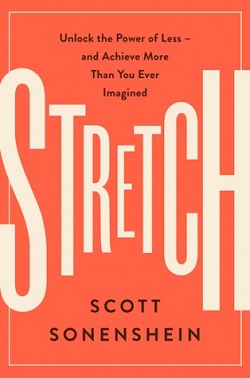 Have you ever needed one thing and had to make do with something else? Maybe you’ve had to use a shoe when you really needed a hammer. Maybe you’ve baked a loaf cake in a sheet pan. Or did you wait and tell yourself you can’t move forward until you find the exact right tool for the situation?
Have you ever needed one thing and had to make do with something else? Maybe you’ve had to use a shoe when you really needed a hammer. Maybe you’ve baked a loaf cake in a sheet pan. Or did you wait and tell yourself you can’t move forward until you find the exact right tool for the situation?
Depending on your answers you might be a chaser who is always searching for newer and better resources. Or, if you’ve adapted when you had to and made do, you might be a stretcher.
People, it turns out, are really bad at gauging what we need (spoiler: the answer isn’t always “more”) and we’re even worse at estimating our ability to make more out of what we have–something most people routinely underestimate.
Stretching can’t solve every problem. But it can solve a few–especially when the biggest challenge is getting started in Stretch: Unlock the Power of Less -And Achieve More Than You Ever Imagined (2017) by Scott Sonenshein.
Sonenshein is an organizational psychologist. In this book he outlines his theory of stretching (making do with what you have rather than growing for the sake of having more) and shares research–both anecdotal and from scientific data–detailing why this approach can be so helpful for so many people and organizations.
Much like in Joy at Work (his collaboration with Marie Kondo). the research and strategies here are approachable and easy to implement. While not every working professional will have the latitude to put these practices into play, the strategies are sound and do help provide options for a mindset shift in approaching problems. As with every new work strategy, there is the risk of leaning in too hard which, in this case could lead to falling into a privation mindset. Sonenshein outlines some of these pitfalls at the end of the book both for individuals and companies.
This slim volume offers chapter-by-chapter strategies guiding readers through how to work with what you’ve got, the causes and consequences of a chasing mindset, the basic benefits of a stretching mindset and the value of knowing a little about a lot as Sonenshein outlines the stretching strategy. In the second half of the book chapters explore why we sometimes perform better without a script (and without all the time and money in the world), how beliefs make us and the people we care about better (or worse), the power of unlikely combinations, and how to get the right stretch.
The book closes with practical strategies and steps to begin stretching in your own life including but not limited to shopping your closet (figuratively or literally), surrounding yourself with new people (and ideas), appreciating what you have, turning trash into treasure, and remembering that when you’re already lost any map will do to get your started.
While not everyone can stretch all the time, Stretch offers practical research and advice for how to embrace flexibility and change–two things that many of us have had to learn often as work situations continue to change in light of current events.

